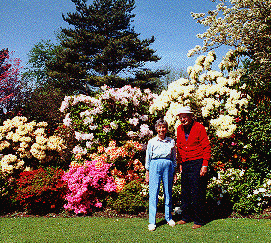|
Bob and Betty Anderson in 1993, a year before he died and thirty-one years after they began creating the garden. |

|
* Introduction * History * Spring Tour * Other Seasons * Fruit and Vegetables * Herbs * Work * Family * Links * * Visiting the Garden * Design Elements * SPECIMENS * Companions * TIPS * GARDEN FURNITURE * History of the Anderson Garden In Enumclaw, Washington--1961-2005 Prehistory History of The First Anderson Garden, Springfield, New Jersey--1938-1961 Pictures of the Beginnings of the Second Anderson Garden, Enumclaw
|
Bob and Betty Anderson in 1993, a year before he died and thirty-one years after they began creating the garden. |

|
In the 1940s and 50s, Bob and Betty Anderson hand-crafted a large stone house and created an eight acre rhododendron park in Springfield, New Jersey. But Bob had read about the Pacific Northwest climate that was ideal for cultivating a wider variety of his favorite plants. He had also read about Buckley loam, a rich, black volcanic soil deposited by Mt. Rainier several thousand years ago. So in the mid-1950's, he rode a Greyhound bus from New York City to Seattle, took the local transit to the end of the line in Enumclaw, and walked the rest of the way to Buckley. Bob loved the dirt but couldn't find the site he was looking for and returned to Enumclaw discouraged. Since there was only one bus a day, he had several hours to wander around. He loved Enumclaw, and found the same world-famous loam. The following year he returned and bought a five acre hayfield at the edge of town.
When Bob and Betty were fifty, they packed everything they could fit into their nursery truck and headed to the Pacific Northwest for good. In the first year, Bob designed the house (he let someone else build this one) and drew up the garden plans, while Betty taught school. In 1962 they moved in and began their transformation of the hayfield and their second rhododendron park.
The garden design reflects influences of northeastern, southeastern (Bob is originally from the mountains of North Carolina) and northwestern styles, and integrates elements of British and Japanese gardens. Bob's training in landscape architechiture at Penn State gave him the technical skills to translate his unique vision into an arrangement of living plants.
One of the most distinguishing features of the garden is its color composition. Bob was an oil and watercolor painter for most of his life, and studied for years at the Art Students' League in New York City. In selecting combinations of plants, Bob paid careful attention to size and blooming season, but he also visualized patterns of color many people would not attempt. But as in an oil painting, two colors that would not seem to mix exhibit a special beauty in the presence of a third. In the garden, he painted from an extensive palette in his mind, able to see how his brush strokes would appear years later.
Over the years, Bob collected more than a hundred species and four hundred different hybrids of rhododendrons (including azaleas.) To provide the several thousand plants needed to complete the garden, he propagated them from cuttings in Nearing frames. Complementing these were hundreds of companion plants--trees, shrubs, and flowers--carefully chosen for form, leaf texture, color, and compatibility.
Because much of the garden came from cuttings, it matured slowly over the years. In the 1960s, the lawn and beds stepped their way outward to the back line. The young garden was sunny and open. In the 70s, the planned contours emerged as different plants grew at different rates. Trees began providing a little shade. By the 1980s, they were large enough to give much of the garden the woodland setting that has characterized it since.
Betty and Bob never sought publicity, but over the years, word spread from person to person. Visitors came from around the country and all over the world. Garden clubs and other groups schedule tours each spring. The American Rhododendron Society brought several busloads of rhododendron enthusiasts in 1993 and 1999 when their national conventions were held in the Seattle-Tacoma area. Bob and Betty never expected this much attention to their garden, but always managed to be gracious to the many visitors.
Several weddings have been held in the garden. Other special events have included a double birthday celebration and numerous parties. Following Bob's death in 1994, a memorial service was held for him in the garden, and his ashes were scattered among the rhododendrons.
In 1996, the garden passed to us in the next generation, John and Doreen Anderson. We moved from the home and northwest native garden we had spent the previous 25 years creating. We hope to continue to develop and nurture the rhododendron garden here and be good caretakers for many years ahead.
In 1996, the garden passed to the next generation, John and Doreen Anderson.© 2001 by John and Doreen Anderson
